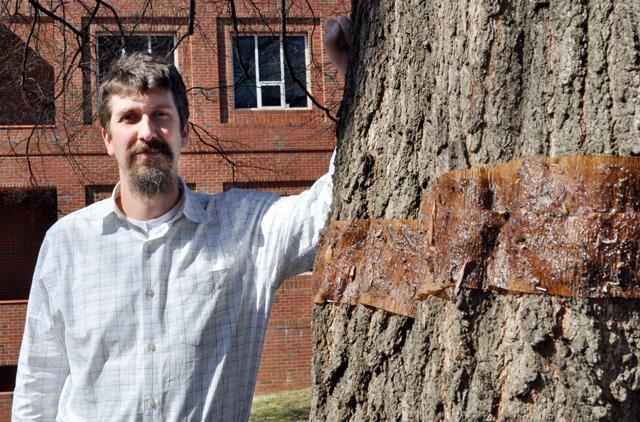In North Carolina, rising temperatures, flowers and frequent rainfall commonly accompany the change from winter to spring. However, another common sign of the changing seasons is harder to describe for many students, no matter how annoying it can get. Spring oftentimes marks the reappearance of small green caterpillars called cankerworms, or Paleacrita vernata, typically last seen during fall.
Last spring, the University received many complaints about the high population of cankerworms, not just because people would find the caterpillars all over their cars and clothing, but also because they would see damages on the trees.
“For me, cankerworms are pretty gross because I’ve never been fond of bugs,” Ryan Hayes, a freshman in First Year College, said. “I believe they should be stopped so that they don’t damage trees.”
Many other N.C. State students, professors, graduates and landscapers felt the same way, and eventually Steven Frank, an assistant professor of entomology, heard their complaints. Specializing in urban trees and urban ornamental plants, Frank developed a plan to address the campus’ problem with cankerworms. Gathering others to help him, Frank spearheaded the “Cankerworm Project.”
“We started the project to try and understand the cankerworms better and understand how to manage them better,” Frank said.
Noukoun “Bobby” Chanthammavong, a junior in biology, helped with Frank’s project.
“I wanted to take part in the Cankerworm Project because it’s an issue that everyone around campus became aware of. It started to become a public nuisance, but what I thought was interesting was that there was a bigger issue at hand, which was that these moths defoliate trees and it could eventually lead to tree mortality.”
Cankerworms transform into moths in the soil and when they emerge, wingless female moths climb up into trees, deposit eggs and then die, Chanthammavong said.
“The eggs hatch when buds start to open and the caterpillars start to feed on the leaves,” Chanthammovong said. “This becomes a problem when there is an overabundance of caterpillars. The caterpillars will then ascend from silk lines from the trees and into the soil to [turn into moths], thus, repeating the life cycle over again.”
To manage cankerworms’ cycle, the Cankerworm Project began last October with Greg Bryant, a research assistant in entomology, and Chanthammavong putting up the sticky bands around campus. Twice a week, they would go to the trees to count the moths and remove them from the bands.
“Stopping the adults from getting up the tree will prevent them from laying eggs in the tree, which should prevent caterpillars [from eating the leaves],” Frank said. “If there’s no eggs, then there’s no caterpillars, and if there’s no caterpillars, then there’s no defoliation.”
According to Chanthammavong, as of Feb. 21, he and other researchers have caught over 16,000 cankerworms on the 36 trees around campus armed with the team’s sticky bands.
In the spring, the team plans to measure several other components to further its knowledge on cankerworms.
“What we’ll do from here is to see whether stopping all the adults we did changes how many eggs get laid in the trees, how many caterpillars end up in the trees and how much defoliation happens to the trees,” Frank said.
The Cankerworm Project members do not know how many cankerworms they expect to catch in the spring because this is their first year of the experiment and the proportion for fall versus spring species is still unknown.
“Right now, we are still counting moths that are climbing up tree trunks, but once that phase ends, we will take clippings of twigs and count egg masses,” Chanthammavong said. “When eggs hatch, we will count the caterpillars, and then towards the end of the project we will assess samples of leaves from all of the trees to measure the level of defoliation using a scanner.”
The team hopes to complete its project by the end of the summer, but Frank said he believes there are other still other aspects of cankerworms worth researching. “I think we’ll keep doing the experiment after this year,” Frank said. “It might change and we might ask new questions in following years, but I think we’ll keep working on it for at least a couple of years. Again, we don’t know really know the biology of this [insect], so anything we learn would help manage it better.”








